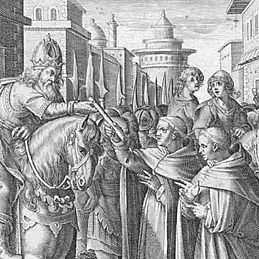552
| Millennium: | 1st millennium |
|---|---|
| Centuries: | 5th century – 6th century – 7th century |
| Decades: | 520s 530s 540s – 550s – 560s 570s 580s |
| Years: | 549 550 551 – 552 – 553 554 555 |
| 552 by topic | |
| Politics | |
| State leaders – Sovereign states | |
| Birth and death categories | |
| Births – Deaths | |
| Establishment and disestablishment categories | |
| Establishments – Disestablishments | |
| Gregorian calendar | 552 DLII |
| Ab urbe condita | 1305 |
| Armenian calendar | 1 ԹՎ Ա |
| Assyrian calendar | 5302 |
| Bengali calendar | −41 |
| Berber calendar | 1502 |
| Buddhist calendar | 1096 |
| Burmese calendar | −86 |
| Byzantine calendar | 6060–6061 |
| Chinese calendar | 辛未年 (Metal Goat) 3248 or 3188 — to — 壬申年 (Water Monkey) 3249 or 3189 |
| Coptic calendar | 268–269 |
| Discordian calendar | 1718 |
| Ethiopian calendar | 544–545 |
| Hebrew calendar | 4312–4313 |
| Hindu calendars | |
| - Vikram Samvat | 608–609 |
| - Shaka Samvat | 474–475 |
| - Kali Yuga | 3653–3654 |
| Holocene calendar | 10552 |
| Iranian calendar | 70 BP – 69 BP |
| Islamic calendar | 72 BH – 71 BH |
| Julian calendar | 552 DLII |
| Korean calendar | 2885 |
| Minguo calendar | 1360 before ROC 民前1360年 |
| Seleucid era | 863/864 AG |
| Thai solar calendar | 1094–1095 |
| Wikimedia Commons has media related to 552. |

Emperor Justinian I receives the silkworms
Year 552 (DLII) was a leap year starting on Monday (link will display the full calendar) of the Julian calendar. The denomination 552 for this year has been used since the early medieval period, when the Anno Domini calendar era became the prevalent method in Europe for naming years.
Events
By place
Byzantine Empire
- July 1 – Battle of Taginae: Narses crosses the Apennines with a Byzantine army (25,000 men). He is blocked by a Gothic force under king Totila near Taginae (Central Italy). In a narrow mountain valley, Narses deploys his army in a "crescent shaped" formation.[1] He dismounts his Lombard and Heruli cavalry mercenaries, placing them as a phalanx in the centre. On his left flank he sends out a mixed force of foot and horse archers to seize a dominant height. The Goths open the battle with a determined cavalry charge. Halted by enfilading fire from both sides, the attackers are thrown back in confusion on the infantry behind them. The Byzantine cataphracts (Clibanarii) sweep into the milling mass. More than 6,000 Goths, including Totila, are killed. The remnants flee, Narses proceeds to Rome, where he captures the city after a brief siege.
- Emperor Justinian I dispatches a small Byzantine force (2,000 men) under Liberius to Hispania, according to the historian Jordanes. He conquers Cartagena and other cities on the southeastern coast.[2]
- Justinian I receives the first silkworm eggs from two Nestorian monks at Constantinople. They were sent to Central Asia (see 550) and smuggle the precious eggs from China hidden in rods of bamboo.
Europe
- Battle of Asfeld: The Lombards under king Audoin defeat the Gepids.
- Cynric, king of Wessex, captures the fortress city of Old Sarum.[3]
- The Roman Catholic Diocese of Meath is established in Ireland.
- Teia becomes the last king of the Ostrogoths in Italy.
Asia
- Yuan Di succeeds Yu Zhang as emperor of the Liang Dynasty.
- Buddhism is introduced in Japan (approximate date).
- July 11 – First year of the Armenian calendar.
- Bumin Khagan dies, new khagan is Issik Khagan of Turkic Empire
By topic
Religion
- The Byzantine church is able to make fabrics, with the intention of developing a large silk industry in the Byzantine Empire.
- Eutychius becomes patriarch of Constantinople.
Births
- Æthelberht, king (bretwalda) of Kent (approximate date)
- John the Merciful, patriarch of Alexandria (approximate date)
Deaths
- Aba I, patriarch of the Church of the East
- Anicius Maximus, Roman patrician
- Aratius, Armenian general
- Bumin, ruler of the Turkic Khaganate
- Columba of Terryglass, Irish abbot
- Dacius, archbishop of Milan
- Hou Jing, regent of the Liang Dynasty
- Mennas, patriarch of Constantinople
- July 1 – Totila, king of the Ostrogoths
- Turismod, prince of the Lombards
- Wang Wei, chief strategist
- Xiao Jing Di, emperor of Eastern Wei (b. 524)
- Yu Zhang, emperor of the Liang Dynasty
References
- ↑ Rance, Philip. "Narses and the Battle of Taginae (Busta Gallorum)". Historia: Zeitschrift für Alte Geschichte Vol. 54, No. 4 (2005), p. 424
- ↑ Getica, p. 303
- ↑ Leeds, E.T. (1954). "The Growth of Wessex". Oxoniensia (Oxford Architectural and Historical Society) LIX: 55–56. Retrieved 6 October 2011.